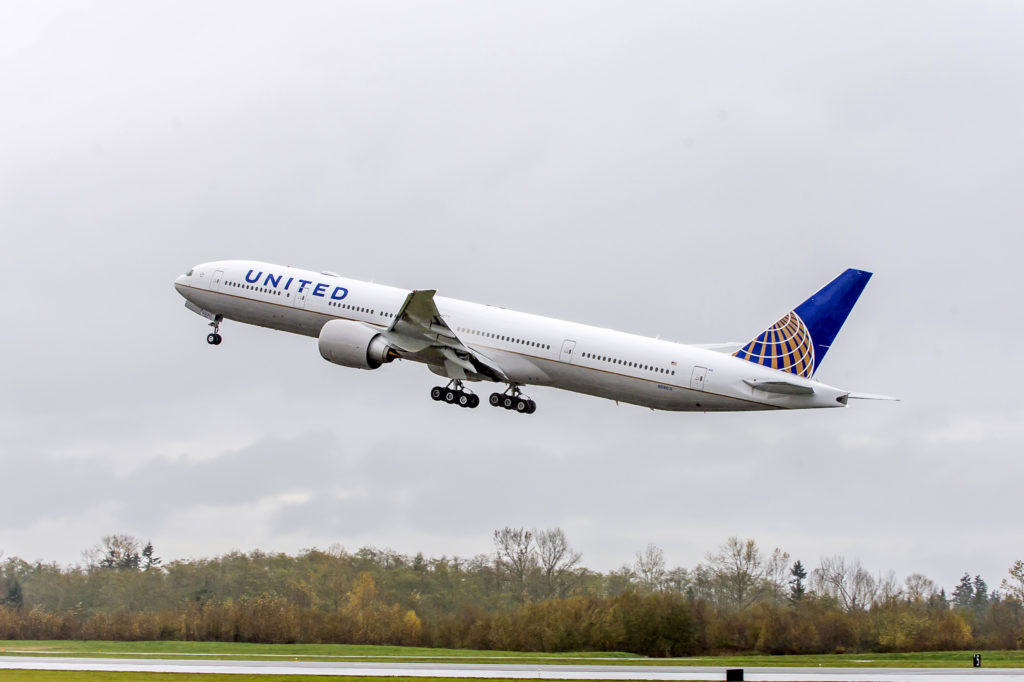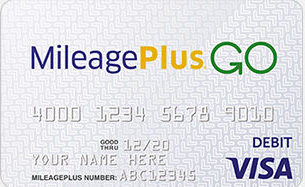United Airlines and Visa are now bucking a decade-long dearth of rewards debit cards with a new product, the MileagePlus GO Prepaid Card. The card isn’t exactly a full-fledged debit option, but is a prepaid card that can be used like a debit card, and earns miles like a credit card.

A year’s spend on a United MileagePlus GO card would earn enough miles (30,000) to score a free economy ticket internationally, but still not as much as a MileagePlus credit card sign-up bonus. Image by United Airlines.
Do you remember the days of debit card rewards? For a $55 annual fee, SunTrust offered two Delta Skymiles per dollar spent on its Delta Debit World Check card (that card has been brought back, but with a paltry one Skymile per dollar earning rate). Charles Schwab used to offer a no-fee two percent cash back debit card. The list went on.
Where did they go?
After financial reforms following the 2008 downturn, banks no longer earned enough from debit card swipe fees to justify incentivizing purchases through points, miles or cash back.
While the rewards are capped at 2,500 United miles per month (cards like the MileagePlus Explorer card offer unlimited mileage earning), the GO card is available to anyone, without a credit check, at any time. Anyone with a US address can order the card online at mileageplusgo.com.

Image by United Airlines.
This new card opens the points and miles game to those who aren’t ready or aren’t inclined to start applying for premium credit cards. There also may be a few other benefactors to the card’s unique earning potential.
Here are the basics:
• The card comes with an $85 annual fee.
• Users earn 1 mile per dollar spent everywhere on the card. Users must select “credit” and sign.
• Miles earning is capped each month at 2,500.
• Users can earn five percent interest on the first $1,000 in average balance and half a percent beyond $1,000.
• Users enjoy no fee withdrawals at MoneyPass ATMs.
• No fee direct deposits can be used to load cash onto the card.
There are some additional fees users should be aware of, including a $2.50 withdrawal fee at any ATM that’s not MoneyPass, a fee of between $2 and $4 to reload at Netspend locations and a three-and-a-half percent fee on foreign transactions. Probably not the best for international United travelers.
Who Should Carry this Card?
The first group of potential benefactors are those who want to earn miles while avoiding fees assessed to credit card payments.
Avoiding three percent fees from everyday credit card transactions and peer-to-peer payments with a miles earning prepaid card may be compelling for individuals with a high volume of these categories of transactions.
If users can max out $2,500 per month in fee-free prepaid spend, which wouldn’t otherwise go on a credit card, MileagePlus GO is an easy choice.
For those who can obtain a points earning credit card, whether it be a premium card like an American Express Platinum (currently offering up to 100,000 points in sing-up bonuses alone), or a basic airline card like the Chase MileagePlus Explorer card, they would be better off going with a credit card on the basis of sign up bonuses alone.
To maximize use of a GO card, a card holder would direct deposit $2,500 per month onto their card, spend the funds fee-free and maintain an average minimum balance of $1,000 to earn at least $50 in annual interest. The result is 30,000 United MileagePlus miles per year for $35 (annual fee less interest earned) with opportunity cost arising from alternative rewards earning debit and prepaid cards (e.g. the SunTrust issued Delta SkyMiles World Debit Card).
Another Group: Unbanked, Underbanked and Debit Card Power Users
About a quarter of American adults are either unbanked or underbanked. The vast majority of this segment are low-income and due to a variety of factors find themselves outside of the mainstream financial services ecosystem.
The result is a further squeeze from check cashing services and money order purchase fees.
Although unbanked and underbanked United MileagePlus Go Prepaid Card holders would likely incur fees in addition to just the $85 annual fee, if prospective card holders have the ability to direct deposit incoming checks, significant savings can be had through cutting out predatory check cashing services in favor of this card.
United MileagePlus miles earned on top of service fee savings would be an added bonus.
Americans still prefer debit cards to credit cards by a roughly 10-percent margin, according to payment processor TSYS. Some consumers, even with high credit scores, remain uncomfortable with credit and prefer to see cash account balances rise and fall directly with every transaction.
This product offers these folks both comfort and access to a rare reward earning prepaid card.
How Are Banks Making Money On This Card?
The Durbin Amendment, passed as part of the financial reforms after the 2008 financial collapse, capped debit card swipe fees at 21 cents, plus five-tenths of one percent of each transaction. Interchange rates — the fees that banks charge retailers — on credit card transactions tend to fall between one percent and three percent of the transaction price.
If banks no longer profit off of debit and prepaid cards, why offer rewards based debit and prepaid products at all? It just so happens that the law exempts banks with less than $10 billion in assets from having to cap interchange fees.
The issuing bank on the United MileagePlus Go Prepaid Card? “Republic Bank & Trust Company” of Louisville, KY, with around $5 billion in assets.
Given that interchange fees on uncapped debit and prepaid transactions are about half of the value of credit swipe fees, it then makes sense to see rewards on these scarce products maxing out at one mile per dollar or one percent cash back.
This product does beg the question whether more airline and hotel brands might be interested in partnering with smaller “community” banks in the future to target the debit and prepaid market.
The Upshot
While not for everyone, there are compelling use cases for carrying the United MileagePlus Go Prepaid Card.
The debit/prepaid market is currently dominated by non-rewards earning cards from big banks, and is a space to keep an eye on moving forward for potential new products issued by smaller banks courting larger travel brands.
What do you think of the United MileagePlus Go Prepaid Card? Are debit or prepaid cards at all on your radar?
The responses below are not provided or commissioned by the bank advertiser. Responses have not been reviewed, approved or otherwise endorsed by the bank advertiser. It is not the bank advertiser's responsibility to ensure all posts and/or questions are answered.
5 comments
Watch Out!!! Take a chance with your money that you might not have access to for several months.
Remember you are dealing with NetSpend. Has reputation for closing down accounts for no good reason and retaining your funds on hold without explanation until you file a CFPB complaint.
Requirement to use Credit functionality eliminates ability to MS via MO so this looks like an $85 ice scraper.
I love the card. I have most of my paycheck direct deposited into my account and have access 2 days earlier than I do funds dd into my traditional bank account. I pay my rent using the card so I get the max number of monthly miles (2500) in a single shot. It’s an easy way to accrue miles without having another cc. The $85 yearly fee doesn’t bother me.
How can I sign up?
[…] What Is The United MileagePlus Go Card? […]